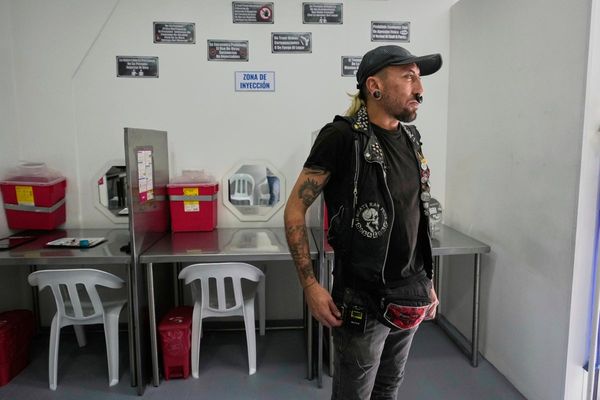
In 1997, Judy Watson exhibited alongside Emily Kame Kngwarreye and Yvonne Koolmatrie at the Venice Biennale’s Australian pavilion. That three Indigenous female artists were selected to be shown at the prestigious event was considered unusual and, in some circles, controversial – there were “predictable howls about political correctness”, the art critic John McDonald wrote at the time – even though the exhibition, which also had Indigenous curators, was positively received.
Almost 30 years on, it is a much more common, and celebrated, occurrence to see Indigenous artists at these large international shows, as the art of the oldest living culture in the world gains more understanding across borders.
But Indigenous Australian art is particularly on the rise in Asia, where the Waanyi artist Watson and the late Kngwarreye are again on display together, this time at the 14th Gwangju Biennale in South Korea. Alongside the APY senior artist Betty Muffler, they make up three of the four Australians in the sprawling show.

And in 2021, Sydney’s Artspace and Seoul Museum of Art collaborated on Un/Learning Australia, a major exhibition of predominantly Indigenous Australian artists, while last year, the National Gallery of Australia’s exhibition Ever Present: First Peoples Art of Australia toured to Singapore – the biggest such show in Asia to date, with work by more than 150 Aboriginal and Torres Strait Islander artists.
Sook-Kyung Lee is artistic director of the biennale and senior curator of international art at London’s Tate Modern. For the Tate, she co-curated A Year in Art: Australia 1992, a current exhibition exploring debates around Indigenous land rights.
As a curator, Lee is interested in Indigenous Australian art as a mode of decolonisation and reclamation, centring lived experiences rather than trading on the titillation of difference.
“In civilisations like Asia, we understand what long history means, and being questioned by modernist or western thinking – I distinctly remember feeling that all these traditional Korean ways were wrong or inferior,” she says.
“Certain aspects of this recent interest in Indigenous art are still quite colonial in only looking at the differences of all these things and not really understanding where this deep culture comes from – so my interest is about what their cultural experience might have been.”
Muffler’s well-known Healing Country series, rendered in black and white dot and line work, is on show in Gwangju, while the Anmatyerre elder Kngwarreye’s signature stripe paintings immediately catch the eye upon wandering into the exhibition’s Ancestral Voices section.

Watson takes the most unconventional and contemporary approach of the three, weaving together science, nature and family histories in her mesmerising esoteric maps. There are hints of nature in the works: a red line snakes down the centre of one, like a darkened river; white marks form the appearance of a branch or a tree in another. And then, elements of man: scientific waves, scrawled annotations. The backdrops of these works suggest topographies, but not in the usual way.
These works – some of which Watson made in collaboration with other artists – are made of natural ingredients gathered around the rivers and creeks of Queensland and named for the places where they were found. “It’s embedded with lots of different meanings, both scientific and cultural,” Watson says.

Her paintings are in the section titled Planetary Times, suggesting a global and even galactic resonance; indeed, they are in conversation with neighbouring pieces of artists from all around the world, all connecting back to the biennale’s theme: “soft and weak like water”, a riff on a Taoist quote about resilience.
Watson believes that the increased interest in Indigenous art in Asia may be due to a lack of previous exposure or experience. She notes, too, that it’s not just visual art that’s gaining recognition across Asia: she remembers traveling to China and finding that students there were fascinated by the works of Indigenous Australian writers such as Alexis Wright.
“I did a residency in India and people there couldn’t believe that Aboriginal culture, archaeology and history was 60,000 years old,” she says. “Education really leads to more understanding – that’s what I think is the biggest thing. More travel, more education, more shifting, more exchange, and more people coming to understand each other.”
Lee believes that societies such as South Korea, known for being monocultural, can benefit from breaking out of myopic cultural views through exposure to different ideas and lives.
“In Asia, seeing homogenous cultures [compared] against the oldest living culture, we see that we’re sharing certain things and I think there’s a beginning of really understanding the whole culture, which gives a sense of hope,” she says.
The Indigenous Australian art on display in Gwangju portrays strength and resistance, in line with the show’s interest in systems and practices that buck against modernist thinking. But more than just a rejection of colonialism, it’s a celebration of the richness and variety of Indigenous Australian culture and experience. “It’s not just the colonised and colonial binary relationship,” Lee says.
“When I’ve travelled around and seen Indigenous work, not necessarily just my own work, it’s very interesting to see the reaction to it,” Watson says. “There does seem to be a thirst.”
The 14th Gwangju Biennale, Soft and Weak Like Water, is on at the Gwangju Biennale Exhibition Hall and various sites throughout the city until 9 July. Guardian Australia travelled to South Korea courtesy of the biennale







